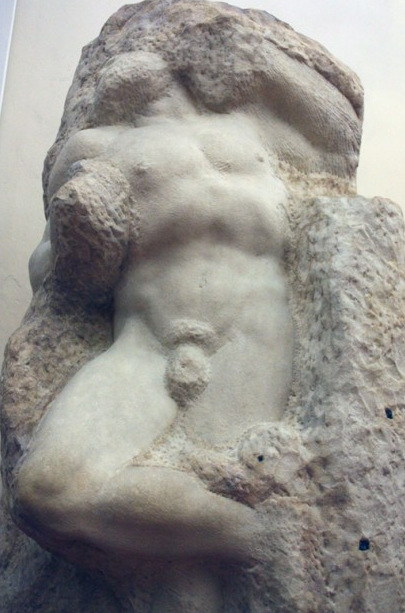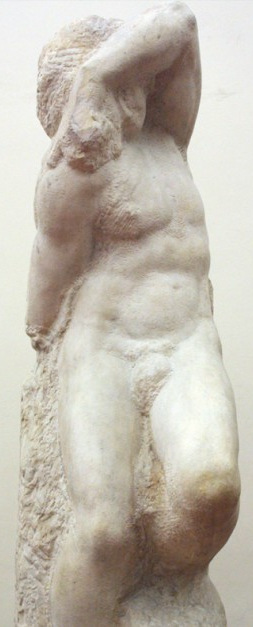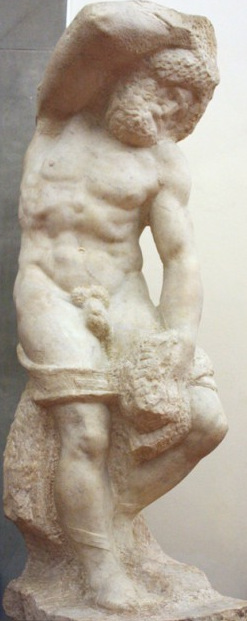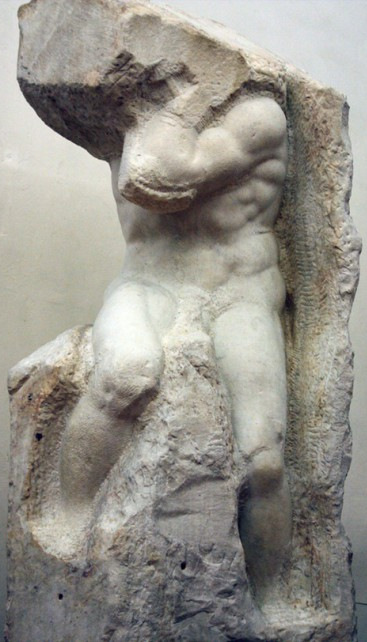
|
|
|
|
|
| Issue 1: | January 2020 |
| Tanka Prose: | 653 words |
| Ekphrastic |
By Charles D. Tarlton
Michelangelo’s Prisoners at the Galleria dell’Accademia in Florence: Untutored Reflections
|
|
|
|
|
|
|
Every block of stone has a statue inside it,
and it is the task of the sculptor to discover it.
—[attributed to] Michelangelo[2]
I always have a good reason for taking something out,
but I never have one for putting something in.
—Rauschenberg[3]
1
I went to Florence to do research on Machiavelli, but I was not at all familiar with the town. I wandered around a lot, stopping for coffee or gelato, trying to translate the Italian newspapers, and wanting to get a feel for the center of the city. I walked across a small piazza in front of a lightly colored building with multiple arches. I poked my head inside and to my surprise there was the original marble of Michelangelo’s David (a large replica of which stands in front of the Palazzo Vecchio, where, I must point out, Machiavelli worked as Secretary to the Florentine government). Off to the side of the rotunda where the David stood was a long gallery housing what looked at first like four unfinished sculptures, parts of a head, an arm, a torso or a thigh protruding from the rough stone. I took them to be very contemporary sculptures, social comment, perhaps, through the durability of stone.
it’s in the modern sensibility to reveal the artist’s labor disturb the work’s seductions keep showing us arms as stone they are metaphors these unfinished-looking works oh, we’re in, we’re out nothing’s ever been finished or perhaps already is said to reveal how these forms emerge from the rock but I imagine the rock is closing over forms the stone is swallowing
2
I’ve tried to see something in these forms to justify calling them prisoners, but they continue to look to me more like bodies in ecstasy. The secret here lies in the body straining against itself, in the throes of something (here the line between orgasm and agony dulls). But either way, the struggle against resistance is reflexive. These are bodies at war with themselves, the age-old wrestle of conscience, ego, lust, God, and pain. So, then, what does the rock mean, the uncut, guileless encompassing stone? Which way is it going—back to the quarry or forward into the world? Think about it this way: he chiseled and scraped and pounded the rock until it yielded the idea, but he chose NOT to end the rapture.
four brothers in toil wrapped in their own twisting forms muscles hard as rock he had to feel the torsion under his hands, the smooth touch he cut them with steel chisels and a wood mallet pounding on the rock with his hunger drawing forth the skin, the muscles, the sex God scooped up a hand full of broken rocks, saying “Can this be human?” and then he turned aside while the stone pulled creation back
3
And, oh yes, the beauty! I don’t care finally what the story is. To know something in the abstract, like, “Michelangelo? Ah, yes, he’s a genius,” is one thing, but to feel it in your own stomach, to feel the precision, the delicacy of these stone stomachs, is something else. It allows each generation to rediscover the perfections in the stone for itself, to marvel on its own at the inexplicable magic in his hands, the imagination that could see through stone, that could hear the cries and stifled breathing under the marble...and work urgently to set them free.
so why then can’t they get all the way free? Why don’t they shake off the rock mantles they’ve been wrapped up in? was he unsure between worlds? can these figures reach beneath the hard divisions between the sexes and boil the subdued passions of both? Men in love with men? all these are questions wayfarers know at crossroads and he carved them out with his hammer and chisel they called him il divino
Publisher’s Notes:
1. Awakening Slave (circa 1520-23), and Young Slave, Bearded Slave,
and Atlas Slave (ca. 1530-34) by Michelangelo di Lodovico Buonarroti Simoni
(1475–1564) are on display in the Hall of Prisoners at Accademia Gallery in
Florence, Italy. Reproductions above were downloaded from an informational guide
created by Accademia dot org: Michelangelo’s Prisoners or Slaves.
2. This quotation has been long and widely attributed to Michelangelo, but with no
convincing evidence that he actually said or wrote it. In 1858, The Methodist
Quarterly Review published a review by Professor Robert Allyn (Ohio University,
Athens) which included this quotation:
“It is the sculptor’s power, so often alluded to, of finding the perfect
form and features of a goddess, in the shapeless block of marble; and his ability to
chip off all extraneous matter, and let the divine excellence stand forth for
itself” (in “Whittier’s Poems,” a book review of The Poems
of John Greenleaf Whittier [Carlton & Porter, New York], quotation on page 78).
The following quotation appeared on 10 July 1879 in “The Simplest Thing in the
World” in The Index: A Weekly Paper Devoted to Free Religion, Volume 10
(page 333, column 2):
“Sculpture, per se, is the simplest thing in the world. All you have to do is
take a big chunk of marble and a hammer and chisel, make up your mind what you are
about to create, and chip off all the marble you don’t want” (Paris Galois).
The same quotation appears in 1888 as “the countryman’s idea of
sculpture” on page 334 of Masters of the Situation, or Some Secrets of
Success and Power by William James Tilley, B.D. (N.D. Thompson Publishing).
And, in 1894, it was attributed to “a rustic” on page 278 of Pushing
to the Front, or Success Under Difficulties by Orison Swett Marden (Thomas
Crowell & Company).
3. The quotation by Robert Rauschenberg (1925–2008), painter, assemblage artist,
printmaker, and collagist, is from an oral-history interview of Rauschenberg by
Dorothy Seckler in New York on 21 December 1965. Transcript is available at Archives of American Art.
Charles D. Tarlton
is a retired university professor of political theory who lives in Northampton, Massachusetts with his wife, Ann Knickerbocker, an abstract painter. He is the author of three books of prosimetra published by KYSO Flash Press: Touching Fire: New and Selected Ekphrastic Prosimetra (2018), Get Up and Dance (2019), and Carmody & Blight: The Dialogues (2019).
Tarlton has been writing poetry and flash fiction since 2006, and his work is published in: Abramelin, Atlas Poetica, Barnwood, Blackbox Manifold, Blue and Yellow Dog, Cricket Online Review, Fiction International, Haibun Today, Inner Art Journal, Jack Magazine, KYSO Flash, Linden Avenue Literary Journal, Prune Juice, Rattle, Red Booth Review, Review Americana, Shampoo, Shot Glass, Simply Haiku, Six Minute Magazine, Sketchbook, Skylark, Tipton, and Ink, Sweat, and Tears.
He also has a poetry e-chapbook published in the 2River series, La Vida de Piedra y de Palabra: Improvisations on Pablo Neruda’s Macchu Picchu; a poem sequence in Lacuna entitled Five Episodes in the Navajo Degradation; and “The Turn of Art,” a short poetical drama pitting Picasso against Matisse, composed in verse and prose, which appeared in Fiction International.
More on the Web: By, About, and Beyond
⚡ The Miletus Torso, ekphrastic tanka prose in KYSO Flash (Issue 9, Spring 2018), which includes an author’s note re Michelangelo’s Atlas Slave
⚡ Featured Author Charles D. Tarlton, with six of his ekphrastic tanka prose and an interview with Jack Cooper, in KYSO Flash (Issue 6, Fall 2016)
⚡ Notes for a Theory of Tanka Prose: Ekphrasis and Abstract Art, a scholarly paper by Tarlton residing in PDF at Ray’s Web; originally published in Atlas Poetica (Number 23, pages 87-95)
⚡ Three American Civil War Photographs: Ekphrasis by Tarlton in Review Americana (Spring 2016)
⚡ Simple Tanka Prose for the Seasons, a quartet by Tarlton in Rattle (Issue 47: Tribute to Japanese Forms, Spring 2015)
| Copyright © 2019-2025 by MacQueen’s Quinterly and by those whose works appear here. | |
| Logo and website designed and built by Clare MacQueen; copyrighted © 2019-2025. | |
|
Data collection, storage, assimilation, or interpretation of this publication, in whole or in part, for the purpose of AI training are expressly forbidden, no exceptions. |
At MacQ, we take your privacy seriously. We do not collect, sell, rent, or exchange your name and email address, or any other information about you, to third parties for marketing purposes. When you contact us, we will use your name and email address only in order to respond to your questions, comments, etc.



